What is ABM and How to Make the Most of it in 2025?
Account-Based Marketing in 2025: Strategies, Technologies, and Best Practices to Drive B2B Growth
Blogby JanApril 26, 2025

Account-Based Marketing (ABM) has transformed from a buzzword to a foundational B2B strategy over the past decade. As we move deeper into 2025, ABM continues to evolve rapidly—shaped by advancing technologies, changing buyer behaviors, and shifting market dynamics.
If you're wondering what ABM really means today and how your organization can leverage it effectively in this new environment, you're in the right place. This guide will break down what modern ABM looks like in 2025, the key innovations reshaping it, and specific strategies to maximize your results.
ABM in 2025: Definition and Core Principles
Let's start with the fundamentals: what is ABM in 2025? Account-Based Marketing is a strategic approach that concentrates sales and marketing resources on a clearly defined set of target accounts, creating personalized buying experiences across multiple channels and touchpoints. Unlike traditional lead-based approaches that cast wide nets, ABM focuses your efforts on the specific organizations most likely to deliver significant revenue.
The core principles of ABM remain consistent. You identify high-value target accounts based on fit, intent, and potential revenue. You research and understand these accounts deeply. You create personalized experiences that resonate with their specific challenges. You align sales and marketing around account-focused strategies. And you measure success at the account level rather than through traditional funnel metrics.
What's changed dramatically is how these principles are executed, the technologies enabling them, and the level of precision possible in 2025's digital ecosystem.
The ABM Spectrum: Three Approaches for Different Needs
Not all ABM is created equal. In 2025, organizations typically implement one or more of these three distinct approaches:
1:1 ABM (Strategic ABM)
The most resource-intensive approach, 1:1 ABM creates completely customized campaigns for individual accounts of significant strategic value. This approach dedicates substantial resources to researching, planning, and executing highly tailored programs for a small number of whale accounts.
When to use it: For target accounts with $1M+ annual potential, complex buying committees, and lengthy sales cycles where the investment justifies the potential return.
1:Few ABM (Scaled ABM)
This middle-ground approach groups similar accounts into small clusters (typically 5-15 accounts per cluster) that share industry, challenges, or use cases. Your team then creates semi-customized campaigns for each cluster rather than each individual account.
When to use it: For high-value accounts with similar characteristics where full 1:1 customization isn't feasible but generic approaches would be insufficient.
1:Many ABM (Programmatic ABM)
The most scalable approach, 1:Many ABM uses technology to deliver light personalization to a larger set of target accounts, typically hundreds or even thousands. While less deeply personalized than the other approaches, modern programmatic ABM still customizes content, messaging, and experiences far beyond traditional marketing.
When to use it: For broader account coverage with moderate customization, often used for mid-market segments or for initial engagement before accounts are escalated to more resource-intensive programs.
Most successful ABM practitioners in 2025 implement a tiered strategy that applies different approaches to different segments of their target account list based on value, stage, and resources available.
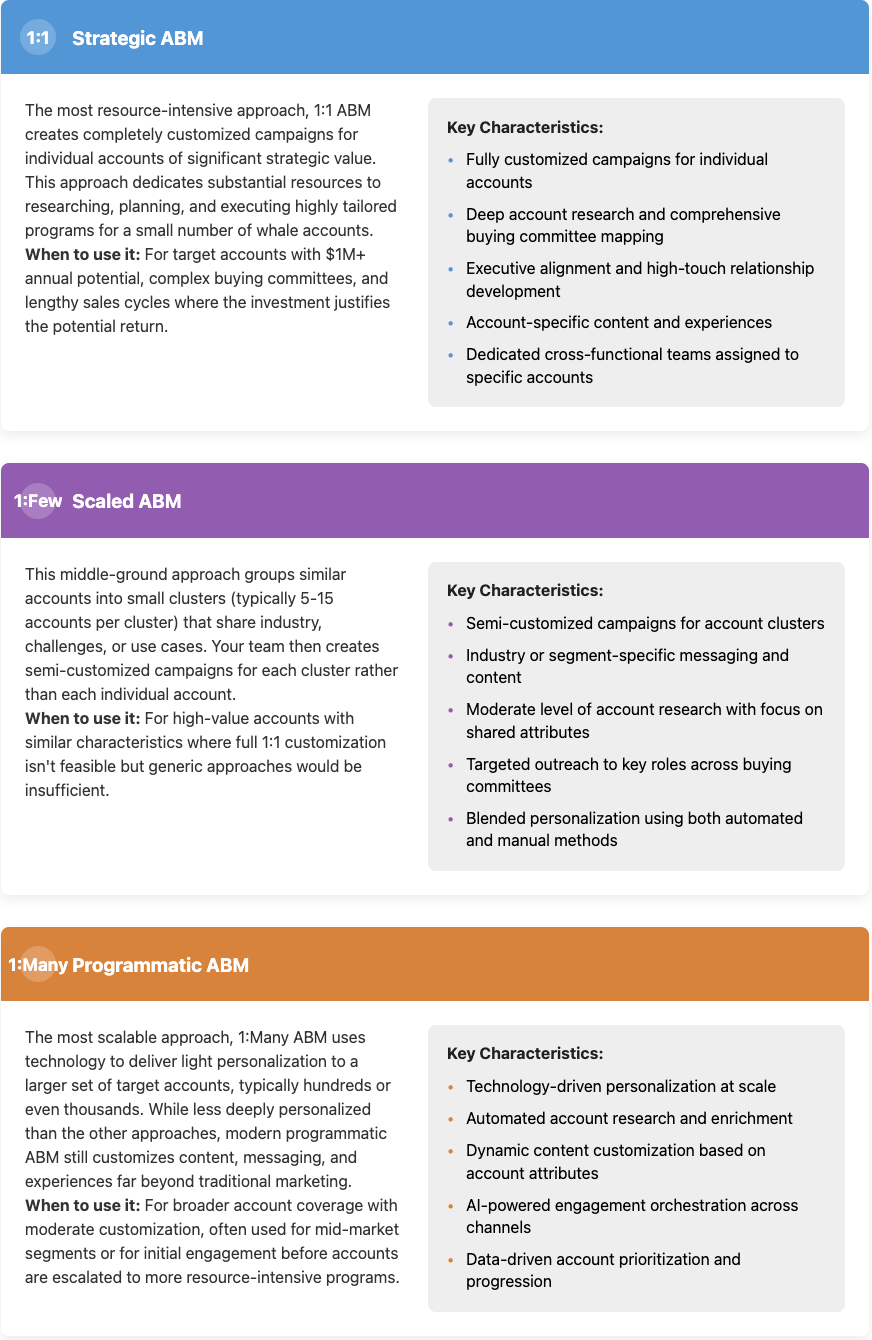
The 2025 ABM Tech Stack: Beyond Basic Platforms
The technology powering ABM has evolved dramatically from the basic tools of previous years. Here's what a cutting-edge ABM tech stack looks like in 2025:
Foundation Layer: Account Intelligence Platforms
Modern ABM begins with deep account understanding. Platforms like Databar.ai serve as the intelligence foundation by enriching account data from numerous specialized sources. They provide comprehensive buying committee mapping and track buying signals and intent data across digital channels. These platforms also identify relationship networks and connection paths while monitoring account changes in real-time.
This intelligence layer powers all subsequent ABM activities with accurate, fresh insights that make personalization meaningful rather than superficial. Without this foundation, even the most sophisticated engagement tactics will fail to resonate with target accounts.
Engagement Layer: Omnichannel Orchestration
The most effective ABM programs in 2025 coordinate engagement across multiple channels simultaneously. They deploy personalized digital advertising with dynamic content that adapts to the viewer's role and interests. They incorporate direct mail and gifting automation for physical touchpoints that complement digital engagement. Account-specific web experiences and microsites deliver tailored messaging based on the visitor's company and role. Email and LinkedIn outreach sequencing maintains consistent communication with key stakeholders. And both virtual and in-person event experiences round out the engagement strategy.
What's changed is the seamless orchestration between these channels—modern platforms coordinate the timing, messaging, and cadence across all touchpoints to create coherent account journeys rather than disjointed channel experiences. This coordination ensures that accounts experience a consistent narrative regardless of how they interact with your brand.
Execution Layer: AI-Powered Personalization
The execution layer has been introduced by AI capabilities that scale personalization in ways previously unimaginable. Dynamic content generation creates account-specific materials without requiring manual customization for each target. Predictive next-best-action recommendations guide sales teams on optimal engagement strategies based on account behavior. Automated buying stage detection adjusts messaging as accounts progress through their journey. Personalized video creation tools enable tailored video messages at scale. And real-time conversation intelligence provides guidance during sales interactions.
These AI capabilities make deep personalization possible at previously unimaginable scale and speed, enabling even smaller teams to execute sophisticated ABM programs that would have required massive resources just a few years ago. The technology doesn't replace human creativity and relationship building, but it amplifies these capabilities through automation of repetitive tasks and intelligent augmentation of human decision-making.
Analytics Layer: Account-Based Attribution
The measurement capabilities for ABM have matured significantly, with modern platforms providing sophisticated attribution that connects activities to outcomes at the account level. Multi-touch attribution identifies how different touchpoints contribute to account progression. Account engagement scoring aggregates interactions across channels into meaningful engagement metrics. Buying committee coverage analysis reveals whether you're reaching the right stakeholders. Pipeline velocity measurement tracks how ABM accelerates opportunity progression. And account-level ROI calculation demonstrates the financial impact of your program.
This advanced attribution enables precise optimization and investment decisions based on actual account impact rather than proxy metrics like lead volume or website traffic. It closes the loop between activity and outcome, giving ABM practitioners the insights needed to continuously refine their approach.
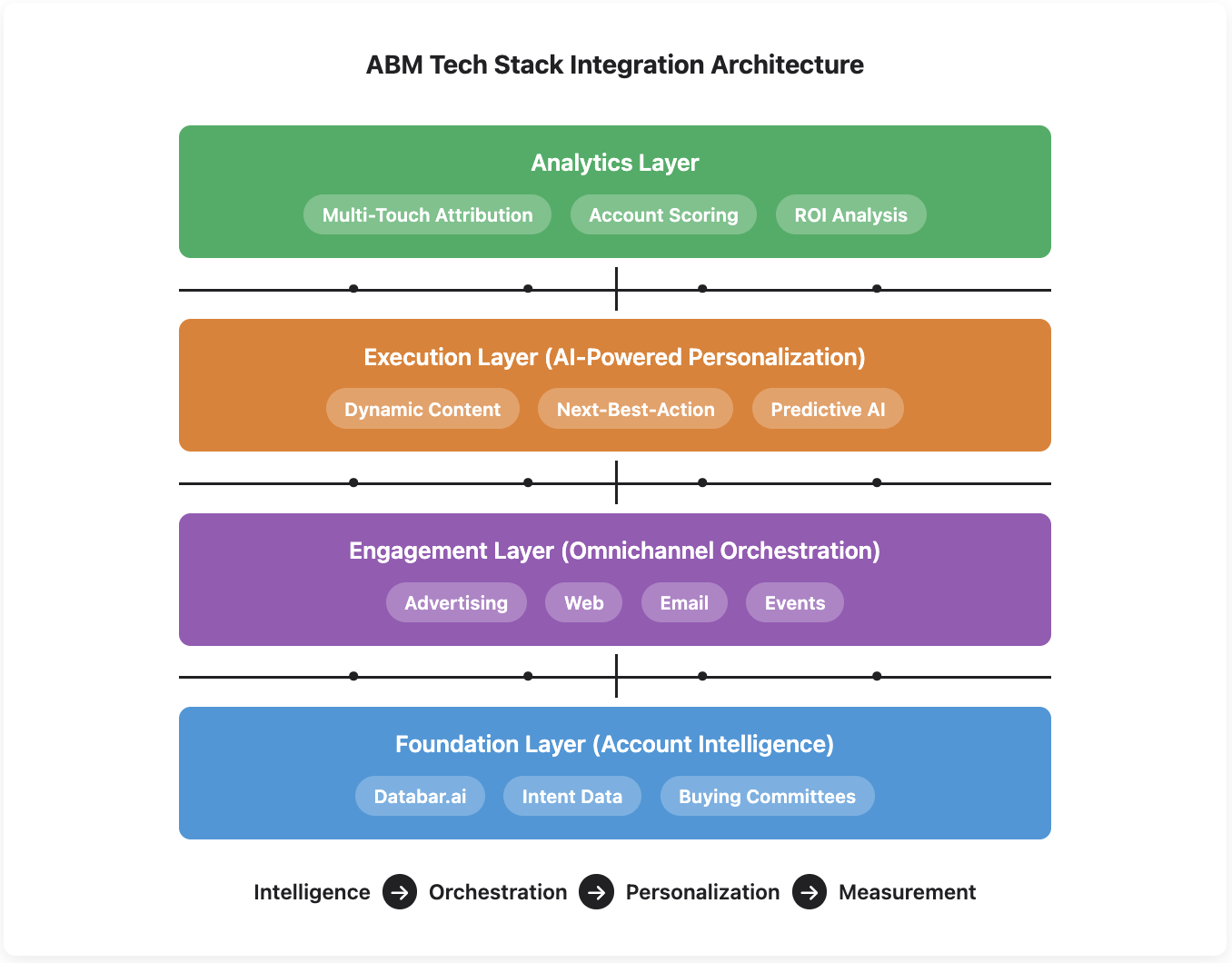
Five Innovative ABM Strategies for 2025
Beyond the technology, several strategic approaches are defining successful ABM in 2025:
1. AI-Augmented Account Research
The most successful ABM teams leverage AI to transform their account research process. Modern platforms like Databar.ai now use AI to automatically analyze vast amounts of account data and surface the insights most relevant for personalization. This capability goes far beyond basic firmographics to identify specific initiatives, challenges, and priorities within target accounts.
For example, AI analysis might identify that a target account is currently implementing a digital transformation initiative focused on customer experience, based on recent executive statements, job postings, and technology investments. This insight allows your team to position your solution specifically in the context of this initiative rather than making generic value propositions.
This AI augmentation allows research that would previously take days to be completed in minutes, dramatically improving both the breadth and depth of account intelligence. The best teams use this technology not to replace human research but to direct it more effectively—having their ABM specialists focus on analyzing and applying insights rather than gathering raw data.
2. Buying Committee Expansion
The average B2B buying committee now includes 7-10 stakeholders across multiple functions, with research showing this number continues to increase yearly. Successful ABM in 2025 focuses explicitly on expanding coverage across these committees.
Leading organizations map complete buying committees using AI-enhanced technologies that identify not just formal roles but influence relationships within accounts. They then develop role-specific messaging and content tailored to each stakeholder's priorities and perspective. This approach recognizes that the CFO, CIO, end users, and implementation team all have different concerns and evaluation criteria, even when considering the same solution.
The most innovative approach combines digital engagement with "sphere of influence" strategies that leverage existing relationships to reach otherwise inaccessible stakeholders. This often involves executive alignment programs that pair your leadership with counterparts at target accounts, creating additional engagement pathways.
Organizations implementing comprehensive committee coverage report 40% shorter sales cycles and 35% higher win rates compared to approaches focused primarily on initial champions or direct buyers. This improvement stems from addressing potential objections earlier in the process and building broader consensus before formal evaluation begins.
3. Account-Based Content Experiences
Content strategy has evolved from simply creating "account-aware" materials to building complete account-based content experiences. Leading ABM programs develop interactive content hubs or microsites for strategic accounts, featuring customized navigation paths, account-specific case studies, personalized ROI calculators, and tailored solution visualizations. These experiences adapt dynamically as buying committees progress through their journey, presenting different information based on engagement patterns and buying stage.
The most sophisticated programs incorporate virtual and augmented reality elements for complex solutions, allowing committee members to visualize implementations within their specific environments. These immersive experiences have proven particularly effective for technical solutions where traditional content struggles to convey full capabilities.
4. Intent-Triggered Orchestration
Timing has become as important as targeting in modern ABM, with leading programs implementing sophisticated intent-triggered orchestration. Advanced ABM platforms now monitor thousands of intent signals across the digital ecosystem, identifying when target accounts show elevated research activity around relevant topics. When specific thresholds are reached, these systems automatically adjust engagement cadence, messaging, and channel mix to align with the account's active buying window.
For example, when a target account shows a 3x increase in research around "data security compliance," the system might automatically accelerate outreach, prioritize security-focused messaging, and alert sales to the heightened interest. This responsive approach ensures your engagement aligns with the account's actual buying cycle rather than arbitrary marketing schedules.
5. Cross-Functional ABM Pods
The organizational structure around ABM has evolved significantly, with leading companies implementing cross-functional "ABM pods" aligned to specific account segments. These pods typically include marketing specialists, SDRs, account executives, solution consultants, and customer success managers working as a unified team rather than separate departments. They operate with shared account-based metrics and often shared compensation structures tied to account outcomes rather than departmental KPIs.
This integrated structure eliminates the traditional friction between marketing and sales, ensuring consistent messaging, seamless handoffs, and coordinated engagement throughout the account journey. It also enables the deep account knowledge needed for true personalization, as the entire pod develops comprehensive understanding of their assigned accounts.
Companies implementing dedicated ABM pods report 58% higher conversion rates from engagement to opportunity and 34% improvement in customer lifetime value compared to traditional departmental structures. The improved coordination and shared accountability create a more coherent experience for target accounts, building stronger relationships and trust throughout the buying process.
Implementing Your 2025 ABM Strategy: A Practical Framework
Phase 1: Foundation Building (Months 1-2)
Implementing a modern ABM approach requires thoughtful planning and execution. Here's a practical framework to guide your implementation. The initial phase focuses on establishing the essential building blocks for ABM success. Begin with account selection and tiering, developing clear criteria for target account selection based on fit, potential value, and likelihood of near-term opportunity. Create a tiered model that specifies which accounts receive which level of ABM approach (1:1, 1:Few, 1:Many).
Next, implement a robust account intelligence platform like Databar.ai to provide the foundational data for your ABM program. Ensure it connects seamlessly with your CRM and marketing automation systems to maintain data consistency and enable coordinated execution.
Finally, establish cross-functional alignment between sales and marketing teams. Develop shared definitions, goals, and metrics that both organizations embrace. Create clear processes for account selection, engagement planning, and progress measurement that involve both teams from the beginning. This alignment is often the most challenging yet most critical element of successful ABM implementation.
Phase 2: Pilot Program (Months 3-4)
Before full-scale implementation, run a focused pilot program to validate your approach. Select a limited account set of 10-15 accounts representing different segments of your target market for initial focus. This allows testing your approach without overextending resources while still providing meaningful data about what works.
For each pilot account, develop detailed account plans covering research insights, key stakeholders, priority messaging, and coordinated outreach strategies. These plans serve as the blueprint for your engagement activities and help align all team members around a consistent approach.
Execute initial campaigns across the pilot accounts, carefully monitoring engagement, response, and initial results. Focus on gathering qualitative feedback as well as quantitative metrics – the insights from sales conversations and account interactions often provide the most valuable guidance for refinement.
Phase 3: Optimization and Expansion (Months 5-7)
Based on pilot learnings, refine your approach and begin scaling. Conduct thorough analysis of what worked and what didn't during the pilot phase. Identify patterns in successful engagements and areas needing improvement. Look for commonalities among responsive accounts and engagement tactics that generated the strongest results.
Make necessary adjustments to your account selection criteria, engagement approaches, content strategy, and technology configuration based on these pilot insights. Often, the most valuable refinements involve simplifying overly complex processes and focusing more resources on the elements that demonstrated clear impact.
Begin expanding to a broader set of target accounts, applying the refined methodology developed during the pilot phase. Implement in waves rather than all at once to maintain quality and allow for continued learning as you scale. This staged expansion preserves the personalization that makes ABM effective while gradually increasing your program's reach.
Phase 4: Full Implementation (Months 8+)
Scale your ABM program to full implementation while maintaining quality. Roll out your complete tiered ABM model, with appropriate resources allocated to each account segment based on potential value and complexity. This often involves implementing different processes and resource levels for strategic accounts versus broader programmatic coverage.
Implement a comprehensive measurement framework that tracks account progression, engagement quality, opportunity development, and ultimate revenue impact. Ensure these metrics are visible to both marketing and sales leadership to maintain executive support and appropriate resource allocation.
Establish a continuous learning loop with mechanisms for ongoing optimization based on results. This includes regular review sessions between marketing and sales, testing frameworks for new approaches, and knowledge sharing across ABM teams. The most successful programs maintain a culture of experimentation and continuous improvement even as they scale.
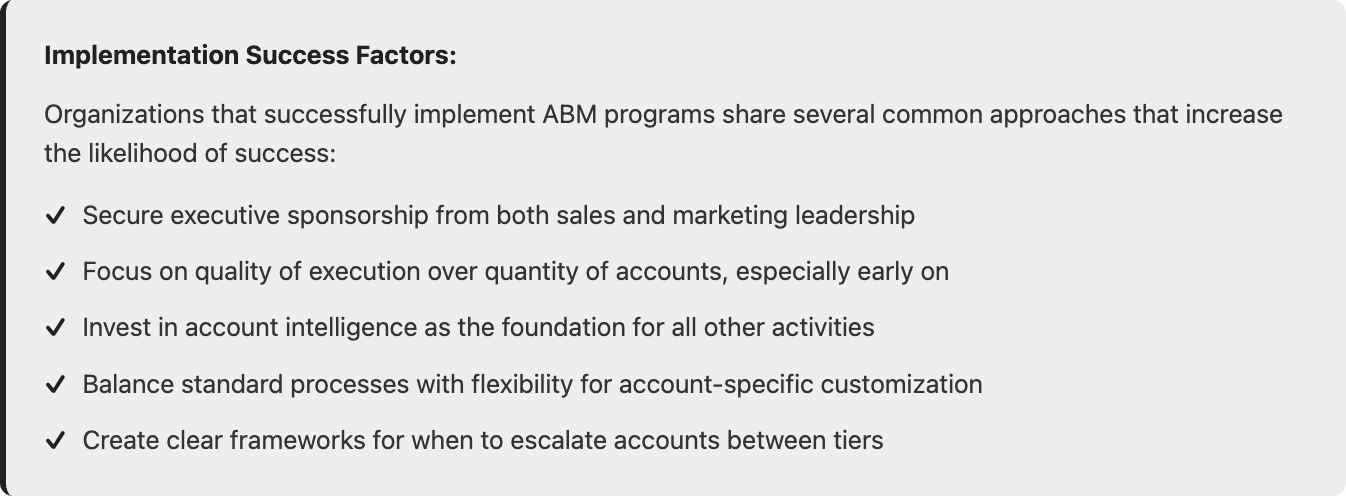
Avoiding Common ABM Pitfalls in 2025
Even with careful planning, certain pitfalls can undermine ABM effectiveness. Here are the most common challenges to watch for:
Data Quality Degradation
As ABM programs mature, data quality often gradually deteriorates without proper maintenance. Initial account research becomes outdated as organizations evolve, stakeholders change roles, and priorities shift. Without systematic refreshes, your ABM targeting and personalization become increasingly misaligned with the current reality of your target accounts.
Implement automated data hygiene processes and regular enrichment cycles to maintain accuracy. Platforms like Databar.ai can schedule regular refreshes of your account data to ensure you're always working with current information. Establish clear ownership for data quality within your team and create processes for capturing and incorporating new account insights as they emerge from sales conversations and other interactions.
Channel Silos
Many organizations implement ABM within certain channels while maintaining traditional approaches in others, creating a fragmented experience for target accounts. For example, marketing might create account-specific advertising and web experiences while the sales team continues using generic email templates and presentations. This inconsistency undermines the cohesive experience that makes ABM effective.
Ensure your ABM strategy spans all customer touchpoints, including often-overlooked areas like customer support, implementation teams, and partner channels. Create shared messaging frameworks and content resources that maintain consistency across these touchpoints. Implement regular cross-functional communications to ensure all teams understand the account strategy and their role in executing it.
Premature Scaling
Expanding ABM coverage before establishing proven processes often leads to diluted quality and disappointing results. The personalization that makes ABM effective requires substantial research, planning, and customization. When organizations rush to cover too many accounts too quickly, these crucial elements get shortchanged, essentially degrading ABM into traditional marketing with minimal customization.
Resist the pressure to scale quickly and instead focus on perfecting your approach with a smaller account set before expanding. Quality of execution consistently outperforms quantity of accounts in ABM results. Establish clear quality standards for your program and maintain them even as you scale, adding accounts only as your capacity to serve them properly increases.
Measurement Misalignment
Continuing to evaluate ABM programs using traditional demand generation metrics creates misaligned incentives and inaccurate performance assessment. Metrics like lead volume, MQL generation, and cost per lead simply don't reflect the reality of account-based approaches, where quality of engagement with the right accounts matters far more than raw quantity.
Develop account-based metrics that reflect the reality of complex B2B buying processes and ensure leadership understands the different measurement approach required. Focus on metrics like account engagement depth, buying committee coverage, opportunity velocity, and account-based conversion rates. Educate executives on the different expectations and timeframes for ABM results compared to traditional demand generation approaches.
Technology Without Strategy
Implementing sophisticated ABM technology without clear strategic direction leads to expensive tools being underutilized or misapplied. Many organizations fall into the trap of believing that purchasing an ABM platform will automatically transform their go-to-market approach, only to find themselves using powerful tools to execute the same outdated strategies.
Always start with strategy and process design, then select technology that enables your approach rather than letting vendor capabilities define your strategy. Be clear about your specific account selection criteria, personalization requirements, and engagement process before evaluating technology options. Choose tools that address your particular challenges rather than those with the longest feature lists.
Conclusion: Making the Most of ABM in 2025
As we've explored, Account-Based Marketing in 2025 represents a significant evolution from its earlier incarnations. The combination of advanced AI, integrated channels, and sophisticated personalization has transformed what's possible in B2B engagement.
Making the most of ABM in this environment requires balancing technological capability with human insight. The most successful programs combine powerful platforms like Databar.ai for intelligence and automation with skilled specialists who apply judgment, creativity, and relationship skills that technology alone cannot provide.
The organizations achieving exceptional results share common characteristics: they maintain unwavering focus on account quality over quantity, invest in deep account understanding before engagement, align their entire revenue organization around account-based approaches, and measure success through account impact rather than activity metrics.
As you develop your ABM strategy for 2025 and beyond, remember that technology enables but doesn't replace the fundamental goal of ABM: creating meaningful connections with the organizations that matter most to your business. When sophisticated tools amplify authentic, value-focused engagement, the results can be transformative.
Ready to enhance your ABM strategy with deeper account intelligence? Try Databar.ai free today and see how comprehensive account data can boost your targeting and personalization.
Related articles
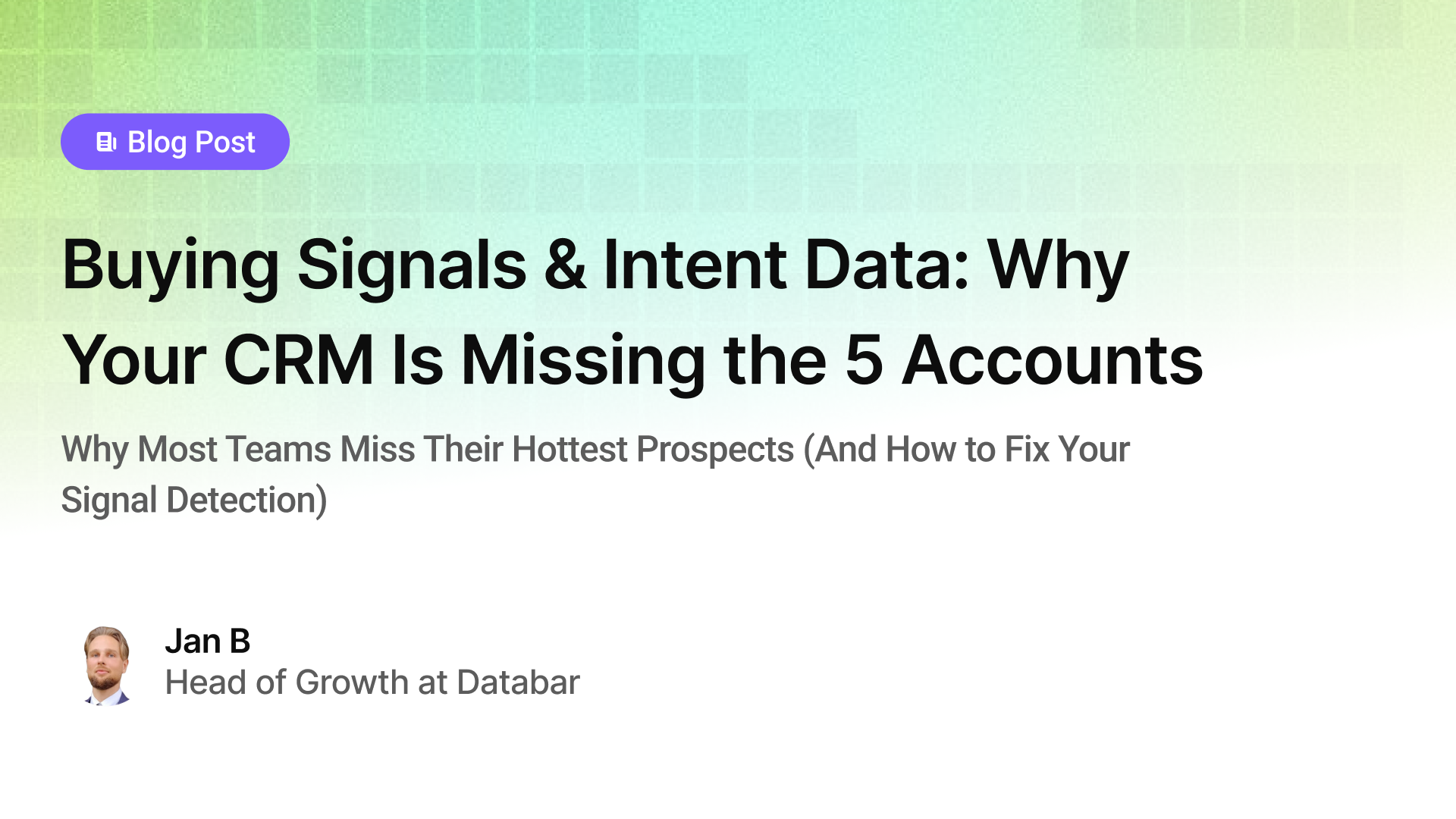
Buying Signals & Intent Data: Why Your CRM Is Missing the 5 Accounts
Why Most Teams Miss Their Hottest Prospects (And How to Fix Your Signal Detection)
by Jan, October 06, 2025

Lead Scoring & Account Segmentation: Why Most CRMs Get This Backward (And How to Fix It)
How to build a system that tells your team who to call, when, and why
by Jan, October 06, 2025
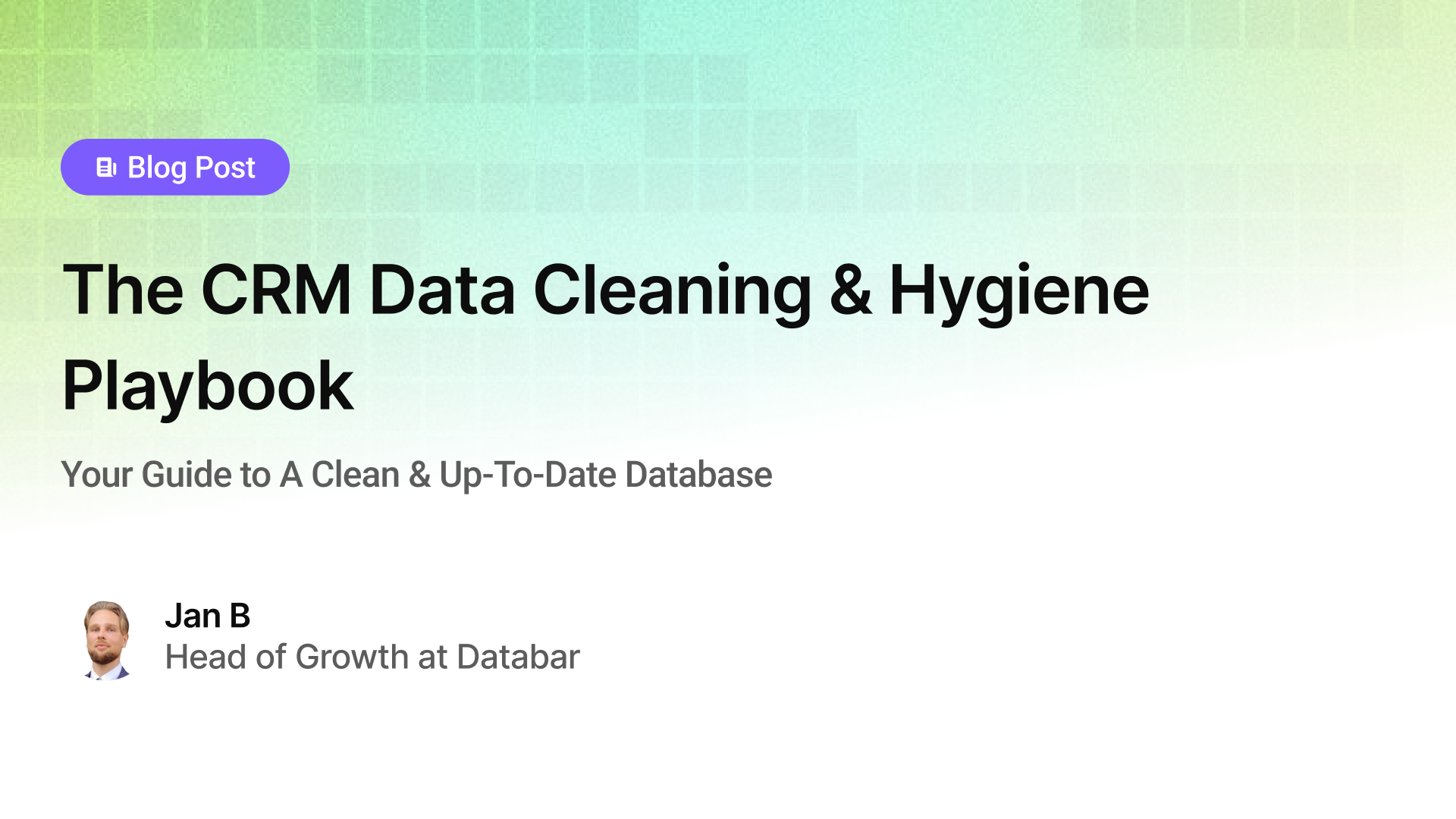
The CRM Data Cleaning & Hygiene Playbook
Your Guide to A Clean & Up-To-Date Database
by Jan, October 04, 2025
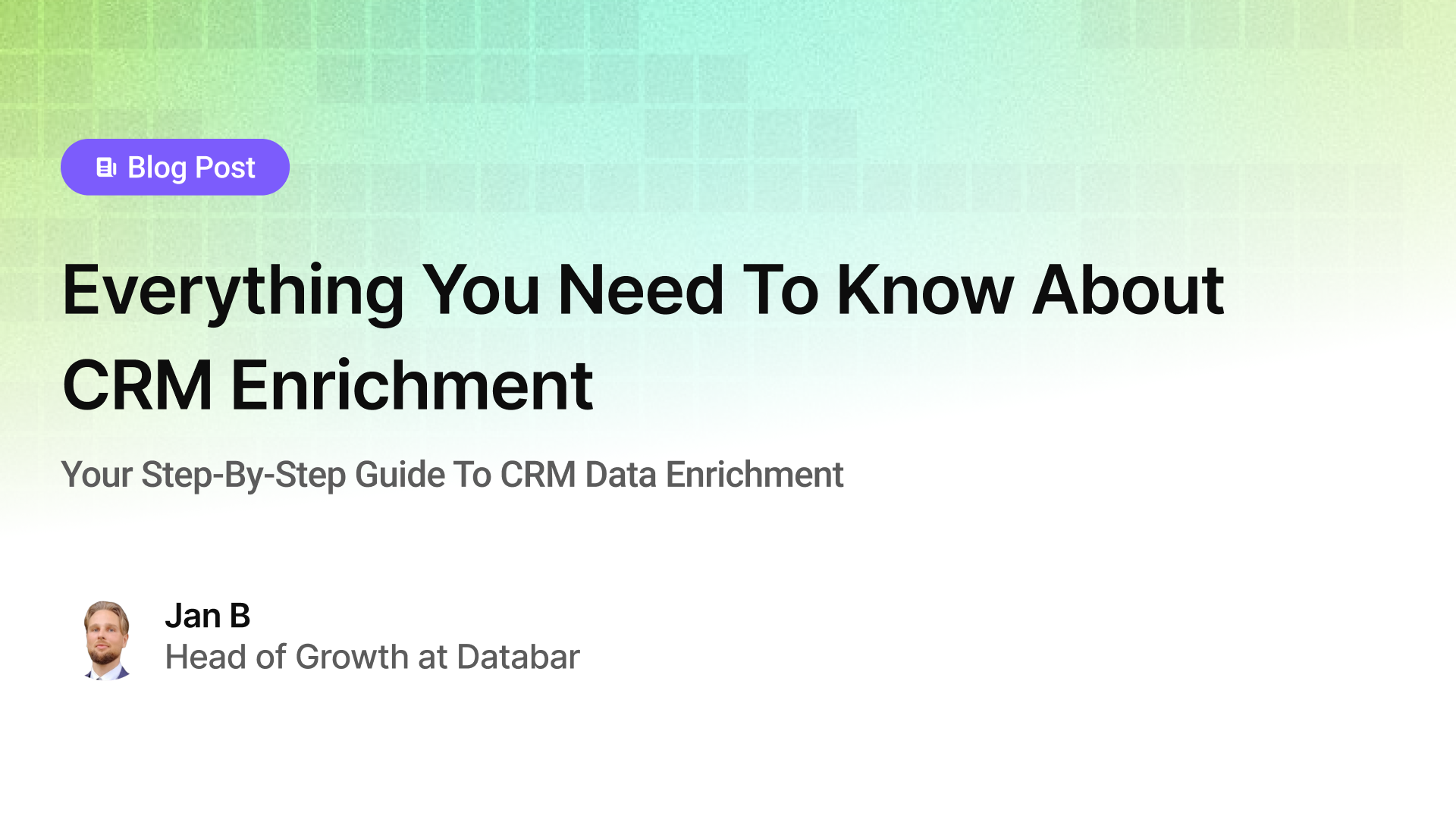
Everything You Need To Know About CRM Enrichment
Your Step-By-Step Guide To CRM Data Enrichment
by Jan, October 03, 2025